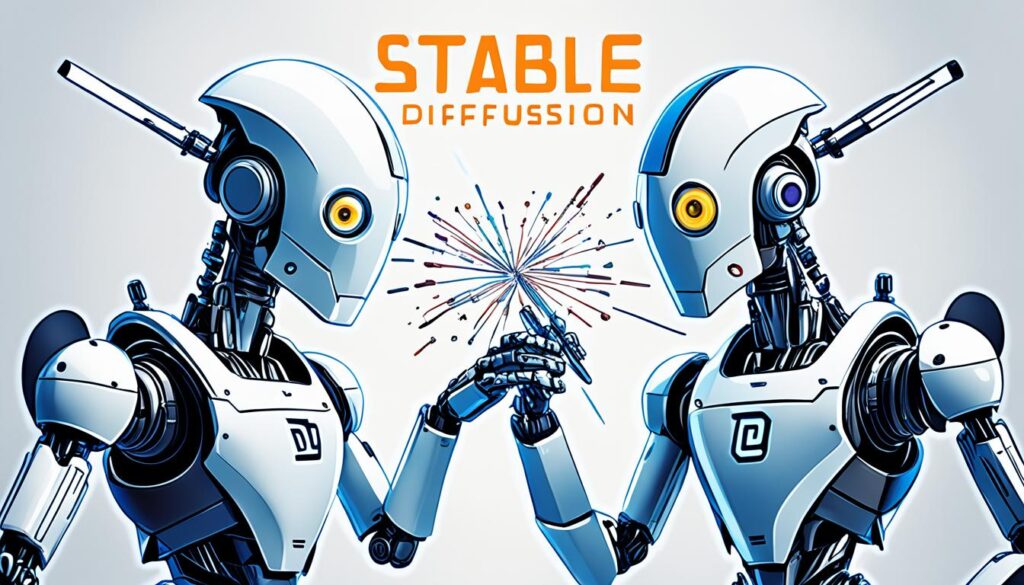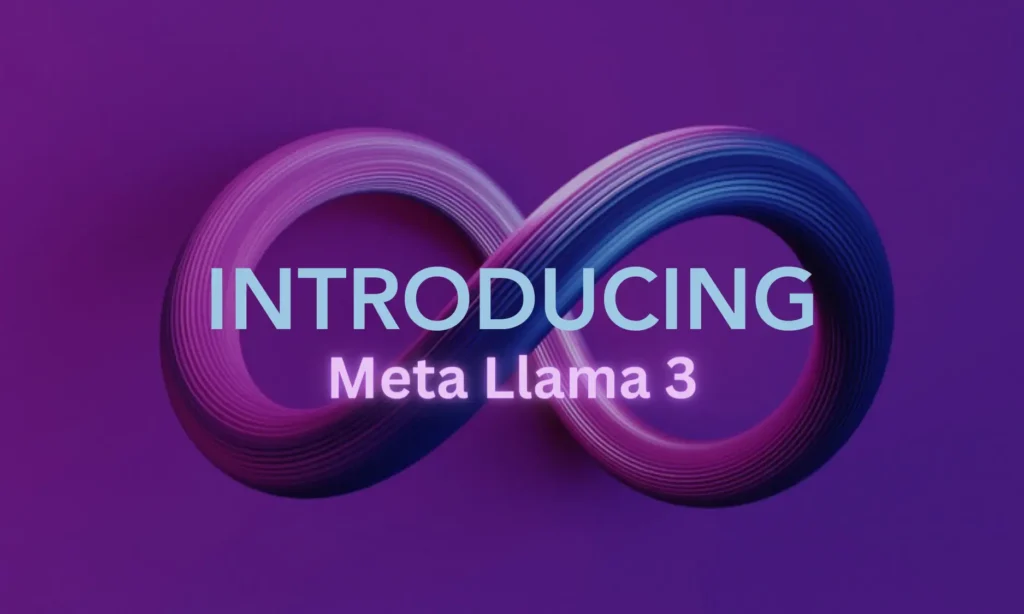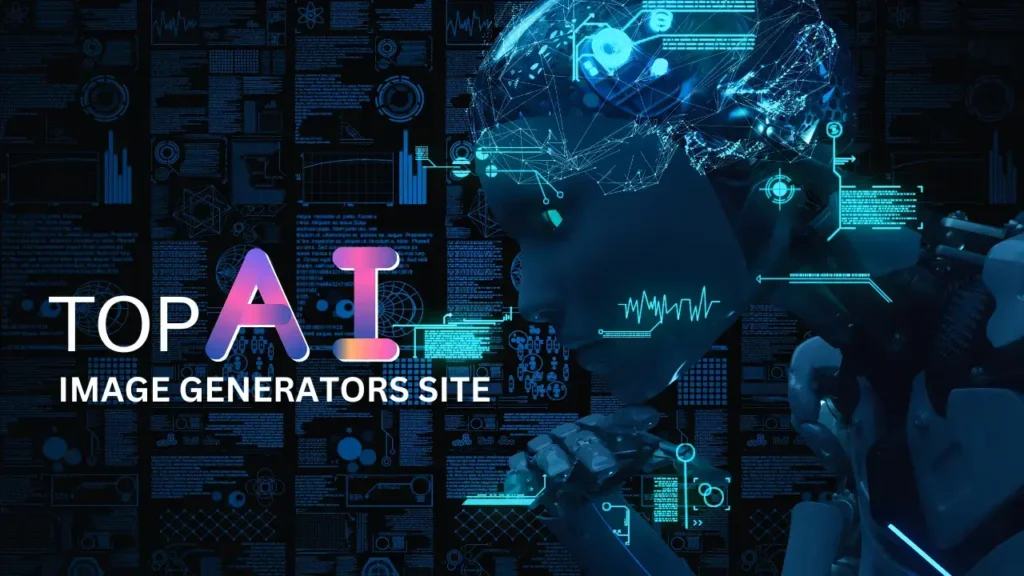I’m an artist and creative pro, and I’m really into AI-powered image generation. The battle between Stable Diffusion and DALL-E 3 has caught my eye. I’m curious to see which one will lead the pack. These models could change how we make visual content.
In this article, we’ll look into Stable Diffusion and DALL-E 3. We’ll see what they’re good at and what they’re not. We’ll also talk about how they might change AI and creative work in the future. This is for artists, marketers, and anyone interested in tech and art.

Key Takeaways
- Stable Diffusion and DALL-E 3 are top AI image generators, each with special features.
- This article will compare their performance, quality, and versatility. It will show their strengths and weaknesses.
- We’ll look at how these AI generators could change the creative world, make art more accessible, and raise ethical questions.
- The aim is to give readers a full view of AI image generation. This will help them choose the right model for their needs.
- We’ll also discuss AI companies and their progress in different areas. This gives more context to our topic.
Rise of Open-Source AI Models
The AI world has changed a lot in recent years. Open-source AI models like Stable Diffusion are now big players, challenging the old guard like DALL-E 3. This change means more people can use AI technology now.
Stable Diffusion is special because it can work on your own computer. This gives users more control and privacy than cloud-based options. DALL-E 3, made by OpenAI, is great at making realistic images from text. But, it was only for those who paid for the premium plan at first.
Thanks to Stable Diffusion being open-source, many developers and fans can work on it together. They use things like LoRA and fine-tuning to make it better. This way, open-source models can move faster than ones owned by companies.
Open-source AI models like Stable Diffusion are changing how we use AI. They let more people and small groups try out these tools. This makes AI more open to everyone, leading to more new ideas.
| Model | Characteristics | Advantages |
|---|---|---|
| Stable Diffusion | Open-source AI photo generator | Runs locally, provides greater control and privacy |
| DALL-E 3 | Proprietary AI model developed by OpenAI | Generates highly realistic and creative images from text |
Open-source AI models like Stable Diffusion are changing AI for the better. They let more people and small groups use and play with AI tools. This way, open-source models can move faster than ones owned by companies, creating a place for more innovation.
The Battle for Supremacy: Stable Diffusion vs DALL-E 3
In the fast-changing AI image generation world, Stable Diffusion and DALL-E 3 lead the pack. They keep pushing the limits of what’s possible. The big question is: which one is the best? Let’s look closely at their strengths to see which AI generator fits your needs best.
Stable Diffusion is known for its high-quality images that look real. It can turn simple text into detailed, beautiful scenes. DALL-E 3, on the other hand, is great at making fun, creative images that spark the imagination.
Stable Diffusion is versatile, doing well in many tasks like changing images and adding styles. DALL-E 3 stands out for its amazing text-to-image skills, making pictures that grab your attention and make you think.
Both Stable Diffusion and DALL-E 3 have easy-to-use interfaces. This makes them great for artists and businesses. Stable Diffusion might have an advantage because it’s open-source. This means it can work well with other tools in creative projects.
The use of AI image generators is growing fast. For example, Canva bought Leonardo AI, a text-to-image company. Stable Diffusion and DALL-E 3 could change many industries. They offer new ways to tell stories and create content in fields like fashion, entertainment, education, and healthcare.
The fight between Stable Diffusion and DALL-E 3 is tough. Each has its own strengths. The choice depends on what you need and what you want to do with AI images. Whether you’re an artist, a business, or just someone interested in AI images, there’s a lot to consider.
Implications for the Future of AI
The battle between Stable Diffusion and DALL-E 3 is changing the future of AI art and content creation. These advanced image generators raise many ethical and societal issues. We must handle these carefully.
One big worry is how these technologies might be misused or show biases. There are reports of AI making fake nude images of women and girls. San Francisco is taking steps to stop this. We need strong rules to keep these AI tools from being used badly.
These AI image generators will change society a lot. They can make very realistic images fast, affecting art, design, journalism, and marketing. We need to think about how they will change jobs, creativity, and how we see images.
But, AI art and content creation also open new business chances. Companies can use these tools to improve marketing and make content faster. They can also find new ways to connect with people. Rules will be key in guiding these technologies, dealing with things like copyright, privacy, and how they work.
The fight between Stable Diffusion and DALL-E 3 shows us the big changes AI will bring. We need to work together to make sure these powerful tools are used right. This means tech companies, lawmakers, and everyone else must work together for the best use of these technologies.
| Implications | Ethical Considerations | Societal Impact | Business Opportunities | Regulatory Landscape |
|---|---|---|---|---|
|
|
|
|
|
The battle between Stable Diffusion and DALL-E 3 is shaping the future of AI art and content creation. We must think about the big issues it brings up. By tackling these challenges early, we can make the most of these new technologies. And we can make sure they are used right.
Stable Diffusion vs DALL-E 3: Which AI Image Generator Wins?
The debate between Stable Diffusion and DALL-E 3 is complex. Both have their strengths and weaknesses. It’s important to look at their performance on different metrics to see who wins.
Stable Diffusion is versatile, creating a wide range of high-quality images. It’s open-source, leading to quick improvements and customization. DALL-E 3, however, excels in detail and realism, perfect for photo-realistic images.
Choosing between Stable Diffusion and DALL-E 3 depends on your needs. Stable Diffusion is great for many users because of its flexibility and ease of use. DALL-E 3 is ideal for professional applications due to its top-notch image quality.
Both models have shown their value in various fields. They’re used in creative arts, design, scientific visualization, and education. The choice between them depends on your specific needs and goals.
Deciding which AI image generator is best isn’t easy. Both Stable Diffusion and DALL-E 3 have unique strengths. It’s best to think about your needs and see which one fits better.
Conclusion
The battle between Stable Diffusion and DALL-E 3 is changing the AI image generation world. Open-source AI models like Stable Diffusion are shaking up the game. They give users more control and make things more accessible.
The future of AI image generators is bright, with new tech like VR and AR on the horizon. These tools will make creating visuals more immersive. AI photo generators could change the game in fields like storytelling and gaming.
But, there are big questions about copyright and the misuse of these technologies. As AI gets better, we need to work together. Developers, users, and policymakers must ensure these tools are used responsibly and ethically.



